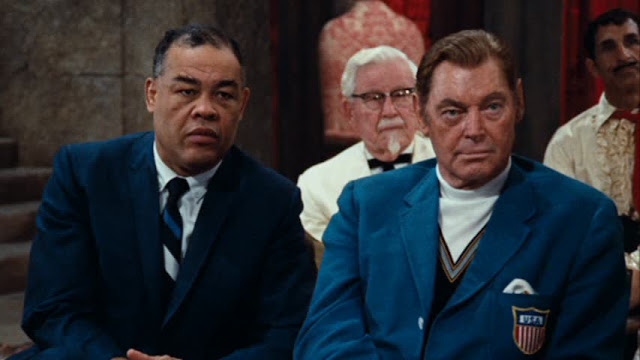I can guess what you're thinking--what's a phynx? Let's investigate.
"The Phynx" is a film released briefly in May 1970 by Warner Brothers Studios. Warner finally released it on DVD in 2012, and I watched it recently on Turner Classic Movies. The movie is certainly not a classic, but it has some amusing moments.
A plot summary is hilarious enough. Communists in Albania have kidnapped a number of celebrities from American entertainment and sports worlds. I don't even remember why. In order to free the hostages, U.S. intelligence puts together a rock band from scratch and turns them into world superstars. The group's name? The Phynx, of course. Once famous, the group can appear in concert in Albania and rescue the celebrities.
But wait--there's a hitch. There's a secret map that will lead the musicians to the castle where the hostages are being kept. The map is drawn in three parts on the tummies of three beautiful young women residing in different European cities. In order to find the pieces, Phynx members must "examine" hundreds of women. After that exhausting ordeal, they put the map together and head for Albania.
Are you with me so far?
Naturally, all the kidnapped celebrities are found and released. A major feature of this portion of the film is a sequence in which they are all introduced to us, the viewers, before leaving Albania. The list includes Johnny Weissmuller and Maureen O'Sullivan (the most famous movie Tarzan and Jane), Leo Gorcey and Huntz Hall (the Bowery Boys), Ed Sullivan, James Brown, Colonel Sanders, Guy Lombardo, Andy Devine, Ruby Keeler, Edgar Bergen, Butterfly McQueen, Jay Silverheels (Tonto), Rudy Vallee, Xavier Cugat, Trini Lopez, Dick Clark, Richard Pryor, Harold "Oddjob" Sakata, George Jessel, and Rhona Barrett.
Alabama native and former heavyweight boxing champ Joe Louis was also included. As the stars leave the castle in horse-drawn carriages, no less, we see duos or trios of them cracking jokes. Johnny Weissmuller says "Me Tarzan, you Jane" to O'Sullivan, a phrase never uttered during any of their many movies together. Louis and Marilyn Maxwell are sitting together and Louis actually makes an income tax joke, referencing his well-known woes with the IRS over back taxes he owed.
This film is crazy, baby, really far out. But I had fun watching it. The parade of mostly-aging, many-by-1970 forgotten stars is a shout-out to people who had entertained millions across the decades. I remember often watching Leo Gorcey and Huntz Hall as the Bowery Boys when I was a kid, on Saturday mornings, I guess. They weren't as funny as the Three Stooges, but were pretty amusing. I also appreciated the appearance of John Hart as the Lone Ranger. I much preferred him over Clayton Moore, whom he replaced in the 1952-53 season during a contract dispute.
The list goes on. Dorothy Lamour! Martha Raye! Joan Blondell! Ed Sullivan! Ruby Keeler! Rudy Vallee! Clint Walker in a hilarious turn as a master sergeant! Oh, and there's Richard Pryer! Butterfly McQueen! Trini Lopez! Sadly, I'm old enough to know who all these people are/were. Check out the film's IMDB entry for a full cast list.
I should note one other appearance. Actress Sally Struthers made her first film appearance, although uncredited, as the World's Number One Fan of The Phynx.
Louis and Weissmuller looking serious earlier in the film. Who's that mysterious gentleman behind them??
















































